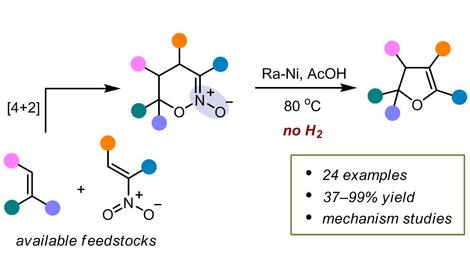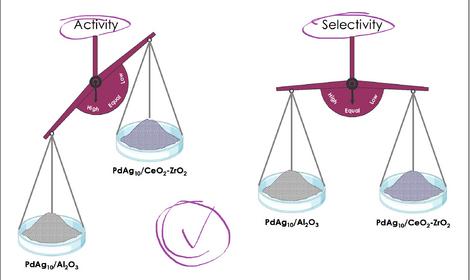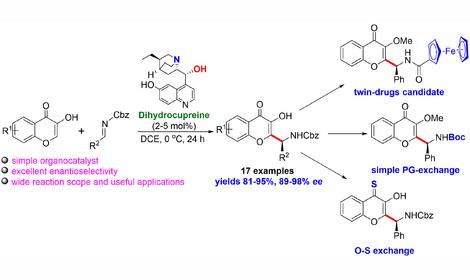Laboratory of Chemistry of Diazo Compounds (N 6)

Head: Prof. Yuri N. Tomilov, DSc (e-mail: tom@ ioc.ac.ru, tel. +7(499)1356390)
Laboratory is part to Department of Unstable Molecules and Small-Sized Cyclic Compounds headed by Oleg M. Nefedov, RAS Full Member
Research areas
Systematic study of reactions of diazo alkanes and diazo esters both as carbene precursors and as reagents of 1,3-dipolar cycloaddition to multiple bonds; development of safe and technology-compatible methods of the cyclopropane moiety introduction to various classes of organic compounds. Targeted research and theoretical support of chemical processes with practical implications; developing a technology of cyclopropanation of strained unsaturated hydrocarbons by diazomethane in the conditions of its simultaneous generation and catalytic decomposition.
Priority research in chemistry of diazo cyclopropanes and cyclopropyldiazonium ions as promising high-reactive intermediates; development of new methods for the synthesis of cyclopropane-containing heterocycles and cyclopropylhydrazones.
New electron-deficient cycloheptatrienes and their stable anti-aromatic anions: the theory, structure, properties and use in the synthesis of polyfunctional carbo- and heterocyclic compounds and metal complexes.
Development of new synthetic methods to afford polyfunctional condensed and carcass azaheterocycles based on the cyclopropylimine rearrangement; chemical transformations of donor-acceptor cyclopropanes and pyrazolines in the presence of Lewis acids for medical chemistry.
Main results
A possibility to accelerate reactions of 1,3-dipolar addition of diazo esters catalyzed by Lewis acids to electron-deficient alkenes was demonstrated. Given that, the reactions can be performed at 20°С during a few minutes. GaCl3 (~300-fold acceleration), Yb(OTf)3 and Sc(OTf)3 (50-100-fold) are acceptable catalysts. Of note is that where GaCl3 is involved one more process actively occurs, i.e. the introduction of the diazo ester electrophilic fragment to the N-H bond of 2-pyrazoline. The course of the target 1,3-dipolar cycloaddition reaction is greatly dependent on the nature of a diazo compound and unsaturated substrate rather than singularly on a Lewis acid in use. (Prof. Yu.V. Tomilov and PhD R.A. Novikov)
The research revealed new transformations of 2-aryl-cyclopropane-1,1-dicarboxilates (donor-acceptor cyclopropanes) with 1- and 2-pyrazolines catalyzed by scandium or ytterbium triflate to yield N-substituted 2-pyrazolines or 1.2-diazabicyclo[3.3.0]octanes. Also, dimerization and cascade oligomerization of these cyclopropanes in the presence of Ga and Sn that gave polysubstituted cyclopentanes and tetralines were found to proceed. Probable mechanisms of the transformations were proposed and studied, including with the use of low-temperature NMR spectroscopy on 71Ga и 35Cl nuclei to fix intermediates. A new pathway of dimerization of diesters of 2-arylcyclopropane-1,1-dicarbonic acids was found for the first time. The latter transform stereospecifically to trimethyl-1-metoxy-3,6-diaryl-2-oxabicyclo[3.3.0]octane-5,8,8-tricarboxilates under the action of 20 mol.% GaCl3 and dimethyl-3,5-dimethyl-1-pyrazoline-3,5-dicarboxilate. The prepared compounds are analogs of natural substances that exhibit various types of biological activity. (Prof. Yu.V. Tomilov and PhD R.A. Novikov)
Convenient synthetic procedures were developed to prepare condensed heterocyclic compounds bearing a pyrrolidine moiety on a basis of the thermal iminocyclopropane-pyrroline rearrangement of 2-cyclopropylbenzimidazoles, thiazoles and benzothiazoles. 2-Spiropentylbenzimidazoles are also engaged in a similar rearrangement and the reaction runs exclusively with a breakage of the СН=СН2 bond of the first cyclopropane ring. Influence of the substituents in the benzene and cyclopropane rings on the rearrangement rate and selectivity was studied. An environment-safe method was proposed with a view to perform the process without solvents, viz. by fusing of the starting compounds with ammonium hydrohalogenides. The methodology developed for the preparation of pyrrolo[1,2-a]benzamidozoles has been used to synthesize a precursor of the anticancer medication Yujungamycin and its close analog, a corresponding trifluoromethyl derivative. It has been shown for the first time, taking hydrohalogenides of 2-cyclobutyl-substituted benzothiazole and N-benzylbenzimidazole as an example, that the cyclobutyliminium rearrangement can proceed to yield a condensed 6-member cycle. (Prof. Yu.V. Tomilov, PhD D.N. Platonov, and PhD R.F. Salikov)
A unique cascade reaction of dimethyl bromomaleate with alkyldiazoacetate in pyridine was discovered. It allows a one-step preparation of heptamethyl ester of cyclohepta-1,3,5-triene1,2,3,4,5,6,7-heptacarbonic acid having high C-H acidity (pKa ~7.7) from three bromide molecules and one diazo compound. Heptamethoxycarbonylcycloheptatreinyl of potassium (HMCH-P) was sourced from the prepared heptamethyl ester and its structure was for the first time examined using XRS analysis and 1Н and 13С NMR spectroscopy data. According to the structural studies, the seven-member cycle in a solid state is not flat and the coupling only occurs between five carbon atoms, what is consistent with the anti-aromatic nature of this anion. HMCH-P reactions with electrophilic reagents, in particular with allylbromide and aryl- and cyclopropyldiazonium salts, capable of transforming to polyfunctional carcass compounds or to 3a,7a-dihydroindazoles owing to the involvement of double bonds, were also studied. (Prof. Yu.V. Tomilov and PhD D.N. Platonov)
A new strategy of the selective synthesis of polyfunctional compounds from the nortropene and 3-vinylpyridin-2-one sequence was designed on a basis of an interaction between cycloheptatrieneheptacarboxilate and primary amines. A key role here is played by basicity of the medium. Its increase leads, first, to the exclusive generation of 3-vinylpyridines and next to 5-hydroxy-1-oxo-1,2dihydroisoquinoline derivatives resulting from cyclocondensation of the active methylene fragment by one of the ester groups. The use of ethanol amine and ethylene diamine enables a one-step preparation of substituted 1,3,4,6-tetrahydro[1,4]oxazino[4,3b]- or 2H-pyrazino[1,2b]isoquinolines that are new structural units of analogs of biologically active compounds (Prof. Yu.V. Tomilov, PhDs D.N. Platonov and G.N. Okonishnikova)
It has been for the first time shown that the thermolysis of 1-aryl-3,3а,4,5,6,7,7а-hepta(methoxycarbonyl)-3а,7а-dihydroindazoles in the presence of sterically non-hindered unsaturated substrates is accompanied by the elimination of hepta(methoxycarbonyl)benzene and generation of 1-aryl-3-methoxycarbonylnitrilimines linked to multiple bonds in the form of 1,3-dipoles with pyrazolins and pyrazoles being produced. The thermolysis of 3а,7а- dihydroindazoles in the presence of acetylacetone, azines and aldehyde hydrazones runs also via trapping of the nitrilimine fragment although, due to a partial fragmentation of cycloadducts, the end products are pyrazoles and triazoles. At the same time, a reaction with 4-methyl-1,1-dichloropenta-1,3-diene gives rise to a new type of transformations: instead of addition of the nitrilimine fragment to diene, there occurs formal dechlorination of the starting substrate resulting in hydrazonoyl chloride, on the one hand, and, on the other hand, in 4-methyl-1,1,3-trichloropent-1-en-4-ol, which can be explained merely by kind of an electrophilic transfer of the chlorine atom to the initial substrate molecule.
Selective methods for the synthesis of a few 6,8-dioxabicyclo[3.2.1]octane derivatives with condensed cyclopropane and pyrazoline fragments as well as with spirocoupled oxaspiropyropentane and cyclobutane moieties in the molecule were elaborated. High regio- and stereoselective reactions of cycloaddition of diazo compounds via С=С or С=О bonds of levoglucozenone and some of its derivatives were carried out. A pioneering study on the interaction between diazocyclopropane and levoglucozenone (and its analogs) and alanto- and isoalantolactones was performed. According to it, a reaction of diazocyclopropane with levoglucozenone by the carbonyl group at low temperature in methanol proceeds predominantly with the elimination of nitrogen whereas its addition by the С=С bond with the generation of pyrazolines prevails at 0°С in dichloromethane. Stereochemistry of the synthesized products was studied. Pathways of chemical transformations of the prepared compounds with small-sized cycles in the molecule (dediazotization, hydrolysis, and oxidation) were identified with a view to synthesize optically active synthons, including substituted cyclopropanes and γ-lactones that show promise in the synthesis of new physiologically active substances. (Prof. Yu.V. Tomilov PhDs E.V. Shulishov and R.A. Novikov)




